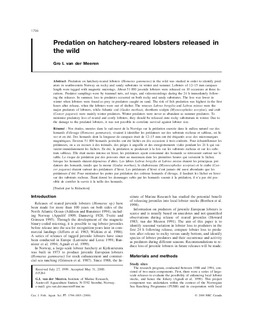| dc.description.abstract | Predation on hatchery-reared lobsters (Homarus gammarus) in the wild was studied in order to identify predators
in southwestern Norway on rocky and sandy substrates in winter and summer. Lobsters of 12–15 mm carapace
length were tagged with magnetic microtags. About 51 000 juvenile lobsters were released on 10 occasions at three locations.
Predator samplings were by trammel nets, eel traps, and videorecordings during the 24 h immediately following
the releases. In summer, loss to predators occurred on both rocky and sandy substrates. The loss was lower in
winter when lobsters were found as prey in predators caught on sand. The risk of fish predation was highest in the first
hours after release, when the lobsters were out of shelter. The wrasses Labrus bergylta and Labrus mixtus were the
major predators of lobsters, while Atlantic cod (Gadus morhua), shorthorn sculpin (Myoxocephalus scorpius), and crab
(Cancer pagurus) were mainly winter predators. Winter predators were never as abundant as summer predators. To
minimise predatory loss of reared and costly lobsters, they should be released onto rocky substratum in winter. Due to
the damage to the predated lobsters, it was not possible to correlate survival against lobster size. | en |
